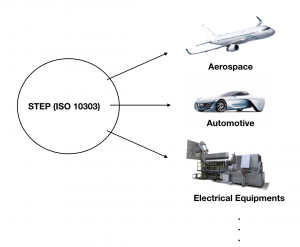STEP stands for “Standard for the Exchange of Product model data”.
Where does the STEP CAD format actually comes from?
The STEP Format stems from an ISO Standard, and are specifically the ISO 10303, which is an ISO standard for the computer-interpretable representation and exchange of product manufacturing information.
This ISO standard is used to represent Objects with 3D CAD models along with their related information.
The STEP format started to be developed in 1984 as a successor of IGES format…
And the main purpose was to represent all the information of a product inside one unique software-independent product model file.
In the following years, the capabilities of STEP were widely extended, primarily for the design of products in the aerospace, automotive, electrical, electronic, and other industries

The STEP format is maybe THE format of reference for CAE simulation as it is a standard in itself for the industry
I won’t detail here the structure of the file because it is much more complex than a simple text file…
In fact you would need to learn several languages of programmatic to understand how it works
(The EXPRESS language used to generate STEP files is based on other languages such as Pascal, ADA and C++).
I would like to enter in the real details of how it is composed, but this is far beyond a simple article and I would spend days to resume all the thinking that went into this standard.
But if you are really interest, I suggest you to read this article on wikipedia which will give you much more details.
You will also find a lot of interesting articles on the ISO 10303 on internet as it is a critical topic in many industries related to CAD and 3D modeling.
Now, if you are interested to know how the CAD format can actually influence your CAE simulation, I have wrote more about it in the following article.
Read my article about CAD formats and CAE Simulation:
CAD formats: Which one is the best for CAE?
« Back to Glossary Index
Leave a Reply